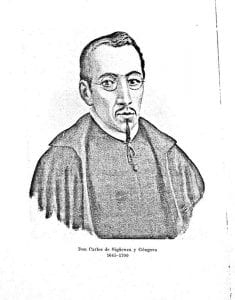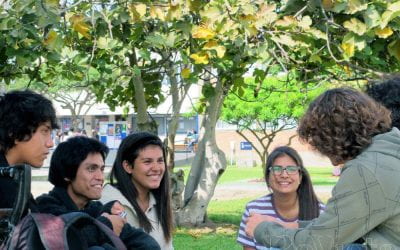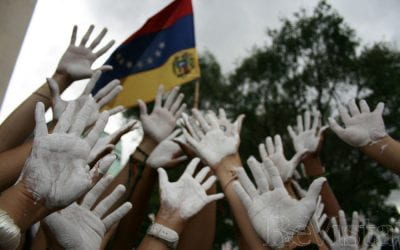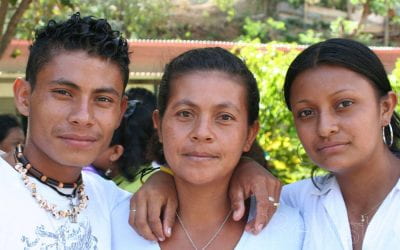Move Over da Vinci!
Latin America’s Heritage of Learning
On the cusp of the “Age of Reason” in Mexico City, the jewel in the crown of Spanish America, the Royal and Pontifical University’s Professor of Mathematics, Carlos de Sigüenza y Góngora (1645-1700) sat at his desk, one may imagine, his fine English microscope standing proudly on his instrument table, the Bible on a lectern in the background, and his astronomical notes and calculations in neat piles throughout the room. As the populace outside cowered in fear at the prospect of the divine retribution forewarned by the most stunning total eclipse of the sun that the Americas would see that century, the scholar “stood with my quadrant and telescope viewing the sun, extremely happy and repeatedly thanking God for having granted that I might behold what so rarely happens in a given place and about which there are so few observations in the books …” This is a man who displayed the new spirit of inquiry that developed in Europe and the Americas from the late Renaissance, as well as that typically modern scientific world view that separates the natural from the supernatural and seeks to chart and understand the world around us rather than huddle in fear at its awesomeness.
Today scholars and policy makers in Latin America look to the universities of the United States as models, but there was a time when Latin America led the way in higher education. If we turn the clock back some twenty generations, or around 350 years, the landscape of the Americas both topographically and intellectually was strikingly different. In North America what little pre-Columbian urban civilization remained had withered under pressure of European diseases, and the Massachusetts Bay Colony could claim the North’s only college, a plucky but tiny institution, which graduated the grand total of nine students at its first commencement ceremony. In contrast, Spanish America could boast true cities with tens of thousands of inhabitants who enjoyed the culture and intellectual life that springs from urban living. Providing higher education to the elite of the vast Spanish territories were almost 40 colleges and two grand universities on the European model in Mexico City and Lima. The Faculty of Medicine in Mexico City serves as a perfect example of Spanish America’s considerable head start in higher education: by 1621 the city’s university had three chairs of medicine (of physiology, pathology and pharmacology respectively), while Harvard would have to wait until after the Declaration of Independence for the foundation of its medical school.
If today the United States often sees its intellectual achievements as the fulfillment of the promise shown by figures such as Benjamin Franklin in physics or Washington Irving in letters, then Latin America’s current achievements and future promise may be seen as building on a more ancient, but no less illustrious heritage that historians are only now beginning to appreciate. Among the forgotten figures in science and letters, none deserves to be remembered more than Carlos de Sigüenza y Góngora. In an age before excessive specialization, when it was still possible for a few men of genius to bestride the length and breadth of human endeavor, figures like Galileo, Athanasius Kircher and Leonardo da Vinci possessed, in the words of the first historian of the Renaissance Jacob Burckhardt: “the highest individual development combined with a mastery of all the elements of the culture of the age.” On such polymaths Burckhardt bestowed the title uomo universale, a “universal” or what we might call today a “renaissance man,” an accolade that Carlos de Sigüenza y Góngora richly deserves.
Born of Spanish parents in Mexico City in 1645, at the age of 15 Carlos de Sigüenza y Góngora entered the Jesuit Order where he received training in rhetoric, philosophy and theology, before moving onto mathematics and “natural philosophy” (what we today call the natural sciences). Despite showing great promise, he was expelled from the Order under mysterious circumstances at the age of 22, whereupon he returned to his studies at the Royal and Pontifical University in Mexico City before briefly disappearing from the records. Still a priest but no longer associated with any particular religious order, he suddenly reappears when he was elected to the coveted chair of Mathematics and Astrology at the precocious age of 27, having come out on top in the battle of wits that characterized academic appointments at the time. He held this position until his death at the end of the 17th century, and in light of his many achievements “the Sun King” Louis XIV of France asked the Creole professor to join his flourishing court at Versailles— an offer he declined. When not teaching at the university or managing the spiritual and financial affairs of the Hospital del Amor de Dios, where he was chaplain, he wrote extensively on astronomy, hydro-engineering, botany, political theory and pre-Columbian civilizations. Although some of his works were undoubtedly for a learned audience, he was also the author of the public report on the Franco-Spanish conflict over the Gulf of Mexico, El Mercurio volante, credited with being Latin America’s first newspaper.
Such a range of achievements, almost unthinkable today, certainly wins Sigüenza y Góngora a place in the annals of American science and letters. However, it is his cultivation of reason and his separation of the natural from the supernatural—the most significant intellectual advance of the age—which sets him apart from the array of prolific scholars from that period and makes him worthy of the title uomo universale. A case in point is his famous dispute with the Jesuit Eusebio Kino over the significance of “Newton’s Comet” (1680), the first scientific controversy in print in the Americas. This intellectual battle between the Creole professor and the feted European scholar and missionary to Baja California pitted two world views against each other. Kino declared that the comet was a sign of divine wrath and foreshadowed terrible calamities on earth, a centuries-old view that was still common in Europe and the Americas. Indeed, this was the accepted interpretation in the British colonies where Increase Mather, the future President of Harvard, ranted that these comets were “warning pieces” that God discharged before his “murdering pieces,” and that the tails of comets caused “drought, caterpillars, tempests, inundations, earthquakes and disease.”
In contrast, Sigüenza y Góngora, while maintaining Christian orthodoxy and admitting that the intentions of the Divine were beyond human ken, rigorously refuted this view in his pamphlet A Philosophical Manifest Against Comets Stripped of their Dominion over the Timid. If Sigüenza y Góngora had merely mustered all the erudition at his command and, in a prose style pungent with the rhetorical spices of baroque Castillian, shown that there was no empirical evidence that the appearance of comets foreshadowed natural disasters, while citing the astronomical work of Kepler and the debates between the atomist Gassendi and René Descartes, his place as one of the foremost intellectuals of the colonial Americas would already have been assured. But he did more than that. He added the vital ingredient which was so central to the Scientific Revolution and the great leap forward in knowledge of and power over nature in the early modern period: prowess in mathematics. At the end of his pamphlet, he appended his observations of the comet and detailed calculations of its trajectory, which also happened to be the first use of logarithms and the newly invented decimal notation in print anywhere in the Americas.
This command of mathematics was also crucial to his achievements in cartography and engineering, for Sigüenza y Góngora was no “ivory tower” academic and he eagerly applied his skills for the good of his home city, overseeing the construction of canals to drain the flood water which frequently overcame whole districts for periods of up to five years. His knowledge of applied mathematics, in particular projectiles, was doubtless also the reason for his being appointed “inspector of the gunners” and why his advice was sought by the Viceroy of New Spain on various matters of defense, especially in the fortification of the Gulf.
Nor did he neglect the arts, that rich area of human endeavor in which the other “renaissance men” such as Alberti and da Vinci expressed their “individual development.” If the premier uomo universale of Italy excelled in painting, Sigüenza y Góngora was a novelist, indeed the author of the very first American novel, The Misfortunes of Alonso Ramirez. This cross between Treasure Island and The Travels of Marco Polo is a literary creation inspired by the true story of an impoverished carpenter taken captive in the western Pacific by pirates who took him on an adventure-filled circumnavigation of the globe before finally freeing him in his native New Spain. A widely studied text today in both the United States and Latin America, The Misfortunes of Alonso Ramirez shows a level of creative genius that many modern scientists—and indeed novelists—would envy.
Yet on the face of it, there might seem to be little that separates “the good professor,” as his biographer Leonard Irving calls him, from the European savants of his age. So what makes him a uniquely Latin American figure? The current author, given his profession, may be forgiven in answering that it is as a historian that his Latin American identity is most apparent. In an age in which the colonial caste system elevated those with pure Spanish ancestry above all other groups and forbade higher education to all but these, the “good professor” learned the local languages and was devoted to the study of the pre-Columbian history of the Americas. Thanks to his close friendship with various members of the Ixtlilxóchitl family, the penniless descendents of the Mexica kings of Texcoco, he learned Náhuatl and other indigenous languages, and built the foremost collection of pre-Columbian artifacts of the day. He dedicated a considerable part of his seemingly boundless energies to these studies, and when he wasn’t tracking the movements of heavenly bodies with the aid of logarithms, improving Mexico City’s drainage system or mapping the Gulf of Mexico, he led archaeological digs around the Temple of the Sun at Teotihuacán and wrote widely on indigenous culture and history. As royal cosmographer he sought to integrate the indigenous and Hispanic heritages by dating his astronomical predictions according to the Mexica calendar, which he had reconstructed from careful study of ancient monuments. In short, although building on a broadly European scientific tradition, his identity and sense of self were rooted in the complexity and contradictions of his native New Spain.
In the context of such rich history, of which Carlos de Sigüenza y Góngora is just one outstanding example, the onward march of Latin America’s universities might be seen as a rebirth, a reclaiming of the region’s heritage. You might even call it a renaissance.
Fall 2012, Volume XII, Number 1
Stuart M. McManus is a graduate student in the History Department at Harvard University, where he is writing a history of rhetoric and oratory in the early modern period, which seeks to chart the transnational impact of Greco-Roman rhetoric in such diverse parts of the globe as Kraków, Quito, Goa and Glasgow. He can be reached at smcmanus@fas.harvard.edu.
Related Articles
University Lessons: Editor’s Letter
I learned about universities on the barricades. Well, not exactly. I was a philosophy student at Barnard—the women’s college at Columbia University—when the uprising began in 1968. Students, including my boyfriend and several classmates, took over buildings to protest…
The Last Word
More than twice as many Latin Americans are attending institutions of higher education than two decades ago, and the number will continue to increase as more students graduate from secondary schools. ReVista’s timely focus on higher education is thought-provoking…
Making a Difference: A Problem With the UN Millennium Goals
Every Saturday for two years, Estevana Sánchez walked through the jungle for miles, in the dark, crossing a river in the rainy season, to finish high school. Her five teenage children did the same. At the end of the trail, they took a long bus ride to the town of San Juan del Sur…





